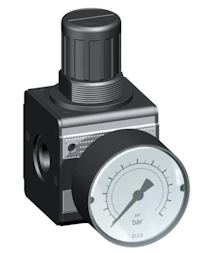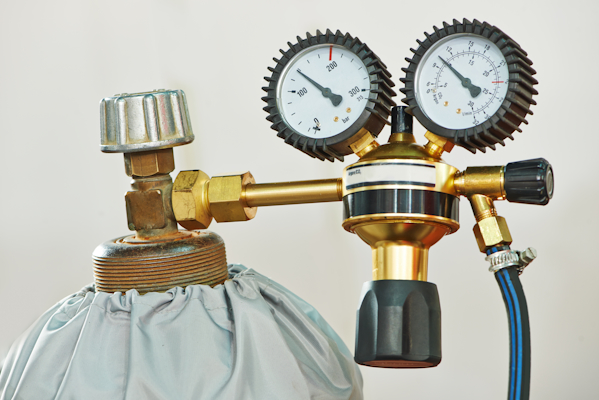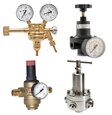How To Troubleshoot Pressure Regulator Issues

Figure 1: A pressure regulator suitable for water and air.
Being able to troubleshoot a pressure regulator allows an operator to efficiently determine if this device is the cause of pressure issues in a system. They are installed upstream of sensitive equipment and control the pressure of liquids or gasses in the system. This positioning protects the sensitive equipment in case of upstream pressure fluctuations. Pressure regulators have the following components:
- Pressure reducing element: The pressure reducing element is typically a poppet valve.
- Sensing element: The sensing element, which affects the position of the reducing element, is a diaphragm or piston. This element responds to downstream pressure by moving between fully open and fully closed.
- Loading element: The loading element is typically a spring that controls the sensing element's sensitivity to downstream pressure changes.
For further information about pressure regulator construction and working principle, read our pressure regulator article.
View our online selection of pressure regulators!
Malfunctioning pressure regulator symptoms

Figure 2: A pressure regulator controls the acetylene gas flowing from the cylinder to the welding tool.
If a pressure regulator malfunctions, serious issues can occur, including damage to equipment and safety hazards. If an operator notices any of the following systems, they should check the pressure regulator to determine if it's operating correctly:
- Fluctuation pressure: Fluctuation of pressure downstream of the regulator is the clearest indication that the regulator is malfunctioning.
- Leakage: Downstream leaks happen because the regulator is not adequately reducing pressure to prevent leaks at vulnerable connection points.
- Noise: Unusual or excessive noise downstream of the regulator can indicate that the pressure has not been adequately reduced. This can cause other system components to work harder and create more noise.
- System failure: Malfunctioning pressure regulators can lead to overall system failure. They should be inspected in case of system failure.
Troubleshooting a pressure regulator
The following steps refer to troubleshooting a pressure regulator for liquid and gas systems. For regulators in pneumatic systems, read our air pressure regulator troubleshooting article.
- Safety: Before uninstalling the pressure regulator, ensure the system is depressurized and can be worked on. Also, wear personal protective equipment such as gloves and goggles.
- Monitor the pressure: Use pressure gauges to monitor system pressure upstream and downstream of the system.
- Look for visible damage: Look at the pressure regulator for signs of damage, wear, or corrosion. If there are any signs of visible damage, replace the regulator.
- Check for leaks: Leaks upstream of the pressure regulator can indicate a faulty regulator.
- Test the regulator: If the regulator is adjustable, change its settings and analyze how the system responds. If the system pressure does not change correctly, the regulator is faulty.
-
Investigate internal components: If the pressure issue is not solved, disassemble the regulator to determine if the internal components have signs of damage or wear.
- Blockages: This is the time to determine if blockages are the issue. High mineral content water can deposit minerals in the regulator, eventually leading to a blockage. Soaking the disassembled valve in calcium and lime remover and then rinsing it clean can usually solve this.
- Look at the manufacturer's guidelines: The manufacturer's guidelines may have specific troubleshooting for the particular pressure regulator model. Consult these guidelines if the above steps do not help.
- Professional help: If unable to determine whether or not the regulator is faulty, seek professional help.
Example pressure regulator troubleshooting
The following example details how to troubleshoot a pressure regulator in a water irrigation system.
-
Identify the problem: Troubleshooting will likely begin when the irrigation system is not behaving normally. This happens if the water pressure is too high or too low.
- Too high: The water may mist out of the sprinkler heads. Also, there may be leakage from the sprinkler heads.
- Too low: The sprinkler heads may not operate at all. Also, there may be inconsistent coverage, leading to longer irrigation times than previously.
- Turn off the system: Ensure the water system is turned off before troubleshooting further.
- Inspect the regulator: Inspect the irrigation pressure regulator for signs of damage or wear.
-
Leak detection: Apply a soapy solution to the pressure regulator's connection points and turn the water back on. If there is a leak, the leaking water will form bubbles in the solution.
- If a leak is found at a connection point, first tighten the connection because it may be too loose. Be careful not to overtighten. If the connection has a sealing gasket or o-ring, determine if either needs to be replaced.
- Different water supply: If possible, connect a different water supply to the irrigation system. This can determine if the issue originates from the original water supply.
- Disassemble: Disassemble the regulator to determine if internal components are the issue or if there is a blockage. If internal components are the issue, replace the regulator. A mineral blockage can be cleaned out in most cases.
- Replace the regulator: If none of the steps above solves the pressure issue, replace the regulator.
FAQs
How do I know if my pressure regulator is bad?
A faulty pressure regulator leads to pressure fluctuations downstream of the device. Also, leaks can form downstream of the regulator.
Why does a pressure regulator go bad?
A pressure regulator fails most often due to age and use. Over time, the internal components wear down and the regulator needs to be replaced.





